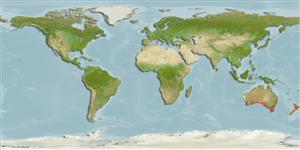Common names from other countries
Classification / Names / Names
প্রচলিত নাম সমূহ | প্রতিনাম সমূহ | Catalog of Fishes (gen., sp.) | ITIS | CoL | WoRMS
Environment: milieu / climate zone / depth range / distribution range
বাস্তুসংস্থান
; গভীরতার পরিসীমা 1 - 125 m (Ref. 74426). Subtropical
Indo-West Pacific: Australia.
Length at first maturity / আকৃতি / ওজন / Age
Maturity: Lm ? range ? - ? cm
Life cycle and mating behavior
পরিপক্কতা | প্রজনন | ডিম ছাড়া | ডিমসমূহ | ডিম্বধারন ক্ষমতা | শুককীট
Members of the order Amphipoda are gonochoric and sexually dimoprhic (males larger than females). Mating behavior: Males locate potential partners with the aid of their antenna to detect the pheromones released by the females; the male then rides or carries the female until the latter is ready to molt. When the female is ready, the male pushes the sperm into the marsupium and releases the female afterwards. A few hours later, the female releases her eggs into the marsupium for fertilization. Life cycle: Eggs are brooded in the marsupium. Eggs hatch into juveniles and remain in the marsupium for a few days. Each species undergo 20 molts at most, i.e., 1-year long life cycle.
Lowry, J.K. 2007. (Ref. 74426)
IUCN Red List Status (Ref. 130435: Version 2024-1)
CITES status (Ref. 108899)
Not Evaluated
Not Evaluated
Threat to humans
Harmless
Human uses
| FishSource |
হাতিয়ার
আরো তথ্য
প্রচলিত নাম সমূহপ্রতিনাম সমূহশিকারী প্রাণী সমূহপ্রজনন পরিপক্কতা ডিম ছাড়া ডিম্বধারন ক্ষমতা ডিমসমূহEgg development
Age/Size
বৃদ্ধি
Length-weight
Length-length
বহিঃ অঙ্গ সংস্থান
শুককীট
প্রাচুর্য
ইন্টারনেট সুত্র
Estimates based on models
Preferred temperature
(Ref.
115969): 14.6 - 20.1, mean 17.1 (based on 298 cells).
